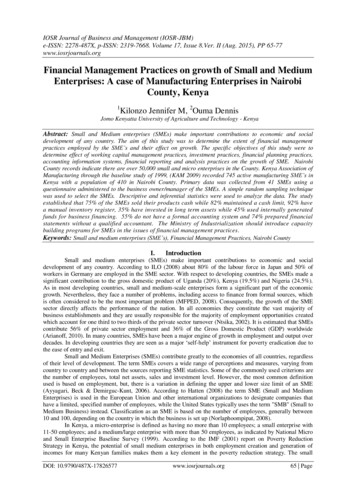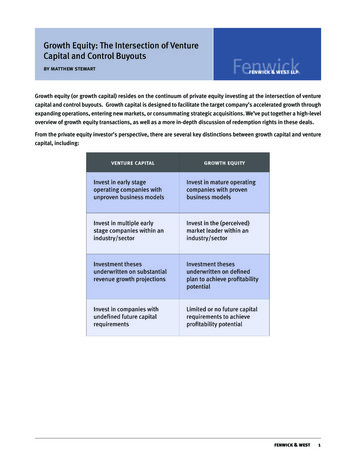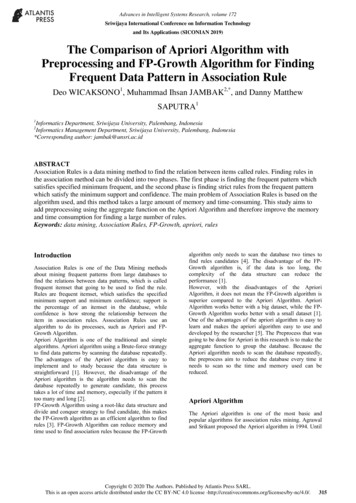
Transcription
IOSR Journal of Business and Management (IOSR-JBM)e-ISSN: 2278-487X, p-ISSN: 2319-7668. Volume 17, Issue 8.Ver. II (Aug. 2015), PP 65-77www.iosrjournals.orgFinancial Management Practices on growth of Small and MediumEnterprises: A case of Manufacturing Enterprises in NairobiCounty, Kenya1Kilonzo Jennifer M, 2Ouma DennisJomo Kenyatta University of Agriculture and Technology - KenyaAbstract: Small and Medium enterprises (SMEs) make important contributions to economic and socialdevelopment of any country. The aim of this study was to determine the extent of financial managementpractices employed by the SME’s and their effect on growth. The specific objectives of this study were todetermine effect of working capital management practices, investment practices, financial planning practices,accounting information systems, financial reporting and analysis practices on the growth of SME. NairobiCounty records indicate there are over 50,000 small and micro enterprises in the County. Kenya Association ofManufacturing through the baseline study of 1999, (KAM 2009) recorded 745 active manufacturing SME’s inKenya with a population of 410 in Nairobi County. Primary data was collected from 41 SMEs using aquestionnaire administered to the business owner/manager of the SMEs. A simple random sampling techniquewas used to select the SMEs. Descriptive and inferential statistics were used to analyze the data. The studyestablished that 75% of the SMEs sold their products cash while 82% maintained a cash limit, 92% havea manual inventory register, 35% have invested in long term assets while 45% used internally generatedfunds for business financing. 55% do not have a formal accounting system and 74% prepared financialstatements without a qualified accountant. The Ministry of Industrialization should introduce capacitybuilding programs for SMEs in the issues of financial management practices.Keywords: Small and medium enterprises (SME’s), Financial Management Practices, Nairobi CountyI.IntroductionSmall and medium enterprises (SMEs) make important contributions to economic and socialdevelopment of any country. According to ILO (2008) about 80% of the labour force in Japan and 50% ofworkers in Germany are employed in the SME sector. With respect to developing countries, the SMEs made asignificant contribution to the gross domestic product of Uganda (20%), Kenya (19.5%) and Nigeria (24.5%).As in most developing countries, small and medium-scale enterprises form a significant part of the economicgrowth. Nevertheless, they face a number of problems, including access to finance from formal sources, whichis often considered to be the most important problem (MFPED, 2008). Consequently, the growth of the SMEsector directly affects the performance of the nation. In all economies they constitute the vast majority ofbusiness establishments and they are usually responsible for the majority of employment opportunities createdwhich account for one third to two thirds of the private sector turnover (Ntsika, 2002). It is estimated that SMEscontribute 56% of private sector employment and 36% of the Gross Domestic Product (GDP) worldwide(Arianoff, 2010). In many countries, SMEs have been a major engine of growth in employment and output overdecades. In developing countries they are seen as a major „self-help‟ instrument for poverty eradication due tothe ease of entry and exit.Small and Medium Enterprises (SMEs) contribute greatly to the economies of all countries, regardlessof their level of development. The term SMEs covers a wide range of perceptions and measures, varying fromcountry to country and between the sources reporting SME statistics. Some of the commonly used criterions arethe number of employees, total net assets, sales and investment level. However, the most common definitionused is based on employment, but, there is a variation in defining the upper and lower size limit of an SME(Ayyagari, Beck & Demirguc-Kunt, 2006). According to Hatten (2008) the term SME (Small and MediumEnterprises) is used in the European Union and other international organizations to designate companies thathave a limited, specified number of employees, while the United States typically uses the term "SMB" (Small toMedium Business) instead. Classification as an SME is based on the number of employees, generally between10 and 100, depending on the country in which the business is set up (Norlaphoompipat, 2008).In Kenya, a micro-enterprise is defined as having no more than 10 employees; a small enterprise with11-50 employees; and a medium/large enterprise with more than 50 employees, as indicated by National Microand Small Enterprise Baseline Survey (1999). According to the IMF (2001) report on Poverty ReductionStrategy in Kenya, the potential of small medium enterprises in both employment creation and generation ofincomes for many Kenyan families makes them a key element in the poverty reduction strategy. The smallDOI: 10.9790/487X-17826577www.iosrjournals.org65 Page
Financial Management Practices on growth of Small and Medium Enterprises: A case business enterprises play an important role in the Kenyan economy. According to the Economic survey report,(2006) the sector contributed over 50 per cent of new jobs created in the year 2005. Recent evidence shows thatSmall and Medium Enterprises (SMEs) form the bulk of Kenya private sector. If Kenya is to becomecompetitive through growth of the private sector, it is inevitable that more attention must be paid to addressingthe key bottlenecks to SME growth and competitiveness (KNBS, 2007). Good financial management practiceshave been viewed as critical elements in the success of SMEs in developing countries. Though SMEs aremaking positive contributions to economic growth and development in Kenya, the rate of failure is high.According to KNBS (2007), the SME sector generated 469,000 new jobs in 2006-2007 financial years, whichwas an increase of 5.7% from the previous year. Despite their significance, past statistics indicate that three outof five businesses fail within the first few months of operation (Kenya National Bureau of Statistics, 2007).Owing to their importance to the Kenyan economy, there was need to conduct a study to investigate financialmanagement practices by the SME‟s and how these affect the business growth.Financial management is one of several functional areas of management which is central to the successof any small business (Meredith, 2006). Financial management is the management of finances of a business inorder to achieve the financial objectives of the business. McMahon et al. (2008) defines financial managementbased on mobilizing and using sources of funds: Financial management is concerned with raising the fundsneeded to finance the enterprise‟s assets and activities, the allocation of theses scare funds between competinguses, and with ensuring that the funds are used effectively and efficiently in achieving the enterprise‟s goal.Financial management as used in this study is composed of five (5) constructs and these include;working capital management which is also subdivided into cash management, receivables management andinventory management. Other constructs under financial management include; investment, financing,accounting information systems and financial reporting and analysis. Ross et al (2009) indicated three kinds ofdecisions the financial manager of a firm must make in business; these include the financing decision, anddecisions involving short-term finance and concerned with the net working capital, investment and financialreporting. Similarly, Ang (2002) indicated three main financial decisions including the investment decisions,financing decisions and dividend decisions. Meredith (2006) asserts that financial management is concernedwith all areas of management, which involve finance not only the sources, and uses of finance in the enterprisesbut also the financial implications of investment, production, marketing or personnel decisions and the totalperformance of the enterprise. However, such areas are not currently well embraced by SMEs in Kenya andurgent attention needs to be paid to. Lack of effective management during SMEs early stages is also a majorcause of business failure for small businesses. Owners tend to manage these businesses themselves as a measureof reducing operational costs.Inefficient financial management may damage business efficiency and this will continuously affect thegrowth of the Small and Medium enterprises. However, efficient financial management is likely to help SMEsto strengthen their business efficiency and, as a result, these difficulties can partly be overcome. Kazooba (2006)argues that though Kenya is among the countries with high start up of SMEs, it also has the highest numbers ofnon performing SMEs as well high number of closure of SMEs. However, the studies conducted did not showhow the components of financial management affect the overall business efficiency of SMEs. A large number ofbusiness failures have been attributed to inability of financial managers to plan and control properly the currentassets and current liabilities of their respective firms (Mbaguta, 2002).Research ProblemAccording to the IMF (2001) report on Poverty Reduction Strategy in Kenya, the potential of smallmedium enterprises in both employment creation and generation of incomes for many Kenyan families makesthem a key element in the poverty reduction strategy. The small business enterprises play an important role inthe Kenyan economy. According to the Economic survey report, (2006) the sector contributed over 50 per centof new jobs created in the year 2005. According to KNBS (2007), the SME sector generated 469,000 new jobsin 2006-2007 financial years, which was an increase of 5.7% from the previous year.According to Wanjohi (2009) starting and operating a small business includes a possibility of successas well as failure. Because of their small size, a simple management mistake is likely to lead to sure death of asmall enterprise hence no opportunity to learn from its past mistakes. This may be attributed to lack ofplanning, improper financing and poor management has been cited as the main causes of failure of smallenterprises (Longenecker, 2006). Though it is clear that SMEs play a critical role in economic development therate inw which newly established SMEs collapsing it is wanting. It is against this realization that the currentstudy aims to investigate the effect of financial management practices on growth of SMES.DOI: 10.9790/487X-17826577www.iosrjournals.org66 Page
Financial Management Practices on growth of Small and Medium Enterprises: A case Research ObjectiveMain ObjectiveThe aim of this study was to determine the extent of financial management practices employed by the SME‟sand their effect on growth.Specific ObjectivesThe specific objectives of this study were:i.To determine effect of working capital management practices on the growth of SMEs in Kenya.ii.To establish influence of investment practices on the growth of SMEs in Kenya.iii.To examine how financial planning practices influence on the growth of SMEs in Kenya.iv.To determine the influence of accounting information systems on the growth of SMEs in Kenya.v.To scrutinize the effect of financial reporting and analysis practices on the growth of SMEs in KenyaHypothesesH1 Working capital management practices influence the growth of SMEs in Kenya.H2 Investment practices influence the growth of SMEs in Kenya.H3 Financial planning practices influence the growth of SMEs in Kenya.H4 Financial reporting and analysis practices influence the growth of SMEs in Kenya.Theoretical FrameworkThe study is based on the Pecking Order Theory. Pecking order theory of capital structure states thatfirms have a preferred hierarchy for financing decisions. The highest preference is to use internal financing(retained earnings and the effects of depreciation) before resorting to any form of external funds. Internal fundsincur no flotation costs and require no additional disclosure of proprietary financial information that could leadto more severe market discipline and a possible loss of competitive advantage. If a firm must use externalfunds, the preference is to use the following order of financing sources: debt, convertible securities, preferredstock, and common stock. (Myers, 1984) This order reflects the motivations of the financial manager to retaincontrol of the firm (since only common stock has a “voice” in management), reduce the agency costs of equity,and avoid the seemingly inevitable negative market reaction to an announcement of a new equity issue.(Hawawini and Viallet, 1999)Implicit in pecking order theory are two key assumptions about financial managers. The first of theseis asymmetric information, or the likelihood that a firm‟s managers know more about the company‟s currentearnings and future growth opportunities than do outside investors. There is a strong desire to keep suchinformation proprietary. The use of internal funds precludes managers from having to make public disclosuresabout the company‟s investment opportunities and potential profits to be realized from investing in them. Thesecond assumption is that managers will act in the best interests of the company‟s existing shareholders. Themanagers may even forgo a positive-NPV project if it would require the issue of new equity, since this wouldgive much of the project‟s value to new shareholders at the expense of the old (Myers and Majluf, 1984).Pecking order theory is important for explaining capital structure changes. By including a discussion ofpecking order theory in the capital structure unit financial managers are exposed to a broad base of both theoryand practice that will enable them to better understand how important financing decisions are made. In additionto the traditional discussion of the impact of taxes, financial distress, and agency costs upon capital structuredecisions, Pecking order theory help financial managers to gain insight to how management motivations andmarket perceptions also impact these decisions. Furthermore, the addition of pecking order theory into the basicdiscussion of capital structure provides one more opportunity for critical thinking to occur. For example, afinancial manager can show how the debt ratios of leading companies in particular industries differ from theindustry averages to which most companies are usually compared during a cross-sectional financial analysis.II.Literature ReviewWorking Capital ManagementPrevious researchers emphasized specific aspects of working capital management. Burns and Walker(2001) examined working capital management as a whole. In their survey of working capital policy amongsmall manufacturing firms in the USA, the following aspects of working capital were considered: workingcapital policy, managing working capital components, including cash, receivable, payable and inventorymanagement, and relationships between working capital management practices and profitability without clearlyhandling other aspects of business efficiency.Wanjohi (2009) conducted a study to elucidate the working capital practices of SMEs in Kenya using asample of 113 SMEs. They concluded that working capital practices are low amongst SMEs as majorityhad not adopted formal working capital routines. Agyei-Mensah (2010) also conducted a research into theDOI: 10.9790/487X-17826577www.iosrjournals.org67 Page
Financial Management Practices on growth of Small and Medium Enterprises: A case working capital practices of SMEs in the Ashanti region of Ghana. Using a sample of 800 randomly selectedfirms the study revealed weak working skils within the sector. Despite the importance of working capitalmanagement to SMEs, a research by Burns and Walker (1991) and Peel and Wilson (1994) show that only 24per cent and 20 per cent respectively of the financial manager‟s time is spent on working capital. Harif et al.(2010) did a research on the financial management practices of SMEs in Malaysia, with the results indicatingthat lack of working capital which accounted for 93.6 per cent is the most common weakness in the area offinancial management.Cash management practices among SMEs were found to be inadequate in the study done byGrablowsky (2008). Grablowsky and Lowell (2008) conducted a questionnaire survey concerned with the cashmanagement practices of 66 small enterprises from a number of industries located in and around Norfolk,Virginia. The results showed that 67 percent of respondents replied they did not do forecasting of cash flows.When asked how they determined the level of cash to be held by the business, less than 10 percent of enterprisesreported using any type of quantitative technique. Additionally, seventy-one percent of business in the Virginiasurvey reported that they had no short-term surpluses of cash in their recent history. Only 23 percent had a longterm surplus. Nearly 30 percent of respondents had invested excess cash in earnings securities or accounts. Themost common investments were savings accounts, certificates of deposit, treasury bills, repurchase agreements,commercial papers, shares, bonds and other investments.In the study conducted by Cooley and Pullen (1979), cash management was seen as the process ofplanning and controlling cash flows. It consisted of three basic components: cash forecasting practices, cashsurplus investment practices and cash control practices. Cooley and Pullen (1979) examined cash managementpractices of 122 small businesses engaged in petroleum marketing and reported that 73 percent of respondentshad experienced a cash surplus. In a divergent view to Grablowsky and Rowell‟s (1978) and Cooley andPullen‟s (1979) survey, Murphy‟s (1979) study indicated that active cash management in small enterprises in theUK was unusual, and that there was little inclination to invest surplus cash on a short-term basis.Regarding accounts receivable management practices, Grablowsky (1976) and Rablowsky and Lowell(1980) found generally low standards. Approximately 95 percent of businesses that sold on credit tended to sellto anyone who wished to buy. Only 30 percent of respondents subscribed to a regular credit reporting service.Most had no credit checking procedures and guidelines, and only 52 percent enforced a late-payment charge.Thirty-four percent of businesses had no formal procedure for aging accounts receivable. Bad debts averaged1.75 percent of sales, with a high of 10 percent in some concerns. Murphy (1978) revealed a very high level ofawareness and utilization of credit control systems in the UK, even in the smallest businesses.The previous studies done on inventory management practices, D‟Amboise and Gasse (1980) studiedthe utilization of management techniques in small shoe and plastic manufacturing industries in Canada andfound 64 percent of shoe and 65.4 percent of plastic businesses employed formal inventory control systems.While Grablowsky and Rowell (1980) found that most of the respondents had in excess of 30 percent of theircapital invested in inventory, the general standard of inventory management was poor. Only six percent ofbusinesses in their survey used a quantitative technique such as economic order quantity for optimizinginventory and 54 percent had systems which were unable to provide information on inventory turnover, reorderpoints, ordering costs or carrying costs. Related to the methods used to determine inventory level, Grablowsky(1984) compared methods used by a sample of 94 small enterprises with those used by large enterprises andfound that large enterprises used methods to determine inventory levels far more than small enterprises.InvestmentBrigham (1995) suggested that capital budgeting might be more important to a smaller firm than itslarger counterparts because of the lack of access to the public markets for funding. Capital budgeting hasattracted researchers over the past several decades. McMahon et al. (1993) claimed the earliest study of capitalbudgeting of SMEs was reported by Soldofsky (1964). During 1961, Soldofsky interviewed 126 owners of smallmanufacturing businesses in Iowa and the results were published in 1964. Regarding capital project selectiontechniques, there were several surveys conducted by previous researchers such as Soldofsky (1964), Luoma(1967), Taylor Nelson Investment Services (1970), Hankinson (1979), Grablowsky and Burns (1980), Proctorand Canada (1992), and Block (1997). Soldofsky‟s (1964) study results shows around 58 percent of respondentsused payback period methods whereas only 4.1 percent employed accounting rate of return technique.Block‟s (1997) survey of 232 small businesses in the USA indicated payback method remains thedominant method of investment selection for small businesses, whereas large corporations widely incorporatediscounted cash flow models in financial analysis of capital investment proposals (Proctor and Canada, 1992).This is not evidence of a lack of sophistication as much as it is a reflection of financial pressures put on thesmall business owner by financial institutions. Payback period was used to evaluate capital projects by 51percent of respondents, while 30 percent reported use of some variation of accounting rate of return. Only 10percent reported use of discount cash flow methods such as net present value (5 percent) and internal rate ofDOI: 10.9790/487X-17826577www.iosrjournals.org68 Page
Financial Management Practices on growth of Small and Medium Enterprises: A case return (2 percent). This finding is consistent with the Soldofsky (1964), Louma (1967), Corner (1967), andGrablowsky and Burns (1980) findings of a tendency in using simple and complicated methods of capitalinvestment project evaluation.FinancingSmall companies frequently suffer from a particular financial problem of lack of a capital base. Smallbusinesses are usually managed by their owners and available capital is limited to access to equity markets, andin the early stages of their existence owners find it difficult in building up revenue reserves if the ownermanagers are to survive. A question concerns how small businesses determine sources of finance in suchdifficult circumstance. According to Brigham (1995), modern capital structure theory began in 1958, whenModigliani and Miller‟s (1958) seminal article on capital structure was published. Since that point of time,researchers have attempted to explain how firms choose their capital structure. Myers (1984) stated: How dofirms choose their capital structure? The answer is we don‟t know we do not know how firms choose the debt,equity, or hybrid securities they issue. This study was based on capital structure theory and Myers‟ PeckingOrder Theory (1984). According to Myers (2004), the Pecking Order Theory (POT) suggests that there is nowell-defined optimal capital structure; instead the debt ratio is the result of hierarchical financing over time. Thefoundation of POT is that firms have no defined debt-to-value ratio. Management has a preference to chooseinternal financing before external financing.When a firm is forced to use external financing sources, managers select the least risky and demandingsource first. When it is necessary to issue external sources, debt issuance is preferred to new equity. In anattempt to explain small firm financing behavior, other scholars have relied on agency theory. Agency theoryholds that investors who have equity or debt in a firm require costs to monitor the investment of their funds bymanagement or the small business owner (agency costs). This view suggests that financing is based on theowner-manager being able to assess these agency costs for each type of financing, and then select the lowestcost method of financing the firm‟s activities. One weakness of this explanation is that no one has yet been ableto measure agency costs, even in large firms (Myers, 2004). Barton and Gordon (1988) suggest that thefollowing characteristics must be accounted for in any explanation of firm financing decisions: behavior at thefirm level; fact that the capital structure decision is made in an open systems context by top management, anddecisions reflects multiple objectives and environmental factors, not all of which are financial in nature. Thefirm‟s financing decision, then, appears to be a product of many internal and external factors, as well asmanagerial values and goals.Thevaruban (2009) examined small scale industries and its financial problems in Sri Lanka. Heunderscored that SMEs of small scale industries in Sri Lanka finds it extremely difficult to get outside creditbecause the cash inflow and savings of the SMEs in the small scale sector is significantly low (Ganesan, 1982;2000). Hence, bank and non bank financial institutions do not emphasise much on credit lending for thedevelopment of the SMEs in the small scale sector in Sri Lanka. Pettit and Singer (1985) study underscored thatfinancing is the most difficult problems of the SMEs in USA. External finance is more expensive than internalfinance (Watson et al., 1998; Datta, 2010). Due to lack of access to external finance (private placements andinitial public offerings of varying sizes), SMEs rely on bank loans as compared to their larger counterparts(Bracker et al., 2006).Ssendaula (2002) lists factors that have discouraged banks from lending to SMEs. Among them arepoorly compiled records and accounts; low levels of technical and management skills; outdated technologies;lack of professionalism and networking; lack of collateral; lack of market outlets due to poor quality and nonstandardized products; poor linkages and limited knowledge of business opportunities. In addition, mostbusinesses, such as those dealing in foodstuffs, have been affected by lack of proper storage facilities. This hasbeen a major limitation on business success because most agricultural products require preservation and have aninelastic demand meaning that even if their prices are lowered, quantity demanded can increase in that sameproportion to clear the market of surpluses.Accounting Information SystemsD‟Amboise and Gasse (1980) studied the utilization of formal management techniques in 25 small shoemanufacturers and 26 small plastic manufacturers in Quebec, Canada and found that 88 percent of thebusinesses used a cost accounting system. Regarding accounting standards, DeThomas and Fredenberger(1985), in a survey of over 360 small enterprises in Georgia, found that the standard of financial record keepingwas very high. In addition to cheque and deposit receipts, around 92 percent of respondents had some form ofrecord keeping. Regarding the use of financial information, DeThomas and Fredenberger‟s (1985) studyindicated that 96 percent of the respondents had financial statements prepared, the responsibility for evaluatingand using the information was within the business itself and only four percent relied on an outside accountantservices.DOI: 10.9790/487X-17826577www.iosrjournals.org69 Page
Financial Management Practices on growth of Small and Medium Enterprises: A case In the survey of 69 small enterprises across the USA, Farhoodman and Hryck (1985) reported on themost important applications of computers, and it was found out that accounting was rated as the highestpercentage. Similarly, Palmer (1994) interviewed 36 small independent retail owner-managers and found that 33percent of the sample businesses used computerized accounting systems. Reviewing previous research resultsshows accounting and financial management applications dominated the use of computers in small and mediumenterprises in the North America in 1980‟s and 1990‟s.Williams (1986) evaluated the adequacy of accounting records for 10,570 failed and surviving smallenterprises operating throughout Australia. The findings are compatible with Peacock‟s (1986, 1987 and 1988)findings in that a significant proportion of owner-managers kept inadequate accounting records. Holmes (1987)conducted a survey of accounting information requirements of 928 small enterprises operating in Sydney,Melbourne and Brisbane. Fifty-seven percent of respondents indicated they used the journal/ledger (doubleentry) systems. This finding is rather in contrast to Peacock‟s (1987) findings of types of records maintained byfailed enterprises, where only 2.1 percent of respondents were found to use double entry systems.Financial reporting and analysisBookkeeping alone without preparing reports is likely not to be fundamental in aiding decision makingunless proper reports are prepared and analyzed to attach a meaning so as to help decision makers. D‟Amboiseand Gasse (1980) studied the use of financial statement analysis by small manufacturers in Quebec, Canada andfound that small manufacturers in shoe and plastic industries formally undertook the analyses based on financialstatements and the findings revealed that manufacturing firms managerial decisions were largely based on thefinancial reports prepared.The research conducted by DeThomas and Fredenberger (1985) found that 81 percent of the smallenterprises regularly obtained summary financial information. Ninety-one percent of the summary informationwas in the form of traditional financial statements (balance sheets, profit and loss statements, fund statements),the remainder being bank reconciliation and operating summaries whereas no business was regularly receivingcash-flow information. The study further found that 61 percent of respondents felt the financial statementsprovided the information they required for planning and decision-making. Nevertheless, only 11 percent ofrespondents reported that they had used financial statement information formally as part of managerialevaluation, planning and decision making, 2 percent of businesses utilized financial ratio analysis, and few madeeven simple historical comparisons.Thoma
management practices by the SME‟s and how these affect the business growth. Financial management is one of several functional areas of management which is central to the success of any small business (Meredith, 2006). Financial management is the management of finances of a business in order to achieve the financial objectives of the business.










